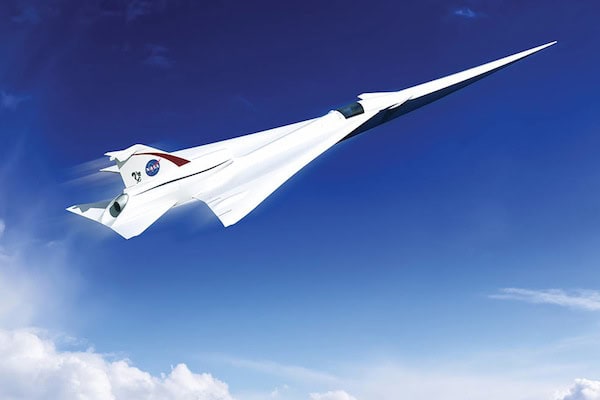
[Image above] An artist’s concept of a possible Low Boom Flight Demonstration Quiet Supersonic Transport (QueSST) X-plane design. Credit: Lockheed Martin
NASA is going in new directions—and not just beyond the moon.
The agency also is spicing things up here within our own atmosphere with its new plan to revolutionize air travel.
NASA’s ambitious 10-year New Aviation Horizons plan seeks “to design, build and fly a variety of flight demonstration vehicles, or ‘X-planes.’” The plan will test several significantly redesigned aircraft concepts, which, if successful, could take to the skies around 2020.
“We’re at the right place, at the right time, with the right technologies,” Jaiwon Shin, associate administrator for NASA’s Aeronautics Research Mission Directorate, says in a NASA press release. “The full potential of these technologies can’t be realized in the tube-and-wing shape of today’s aircraft. We need the X-planes to prove, in an undeniable way, how that tech can make aviation more Earth friendly, reduce delays and maintain safety for the flying public, and support an industry that’s critical to our nation’s economic vitality.”
The X-planes will test “such things as lightweight composites, quieter more advanced engines, quieter landing gear and flap mechanisms, shape-changing wing flaps, and bug-resistant coatings,” according to a Gizmag article. “The agency says that these have the potential to save the air industry $225 billion dollars over a 25-year period.”

Concept illustrations of a few of NASA’s X-planes. Credit: NASA; Lillian Gipson
But to save money, sometimes you have to spend it. Which is precisely why NASA just announced that it’s spending $20 million to push supersonic jet travel back into commercial reality. NASA’s reimaging of the supersonic commercial jet is one of the projects within the New Aviation Horizons plan.
You may recall that not so long ago, supersonic travel did rush passengers back and forth between select worldwide destinations aboard the Concorde supersonic (and superlush) jet. But those destinations were limited because of one huge and hated problem with the Concorde—sonic booms.
The Concorde speeding through the sound barrier created a loud double-boom so noisy to people on the ground below that it prompted laws that prohibited supersonic flight over inhabited areas. Because of this challenge and several others—including fuel inefficiency, environmental concerns, and unsustainable costs—the Concorde made its final flight in 2003.
But despite harassing the ears of people on the ground, the Concorde cruised at around 1,500 miles per hour, making a trip from Washington Dulles to London Heathrow possible in just 3.5 hours. Which is precisely why supersonic travel is still widely appealing.
So NASA is funding $20 million over 17 months to develop Quiet Supersonic Technology (QueSST). The funding is going to a team led by Lockheed Martin for preliminary design work on a reimagined supersonic jet. GE Aviation (Cincinnati, Ohio) and Tri Models Inc. (Huntington Beach, Calif.) are also subcontractors on the project. Hear more about the project in this video from Wired.

Credit: WIRED; YouTube
According to a NASA press release, “The company will develop baseline aircraft requirements and a preliminary aircraft design, with specifications, and provide supporting documentation for concept formulation and planning. This documentation would be used to prepare for the detailed design, building and testing of the QueSST jet. Performance of this preliminary design also must undergo analytical and wind tunnel validation.”
So why does NASA think quiet supersonic jets are suddenly possible?
In the intervening years since the world has been sans commercial supersonic travel, NASA scientists have researched and reimagined supersonic aircraft. NASA’s advanced design concepts show that it’s theoretically possible to minimize the accumulation of sound waves, allowing development of a “low boom” aircraft.
In comparison, the Concorde generated of shockwaves as air flowed around the plane at speeds in excess of 767 mph (the speed of sound). When those shockwaves hit the ground below, they created sonic booms that disrupted eardrums with 106 dB of noise.
“The trick to making airplanes quiet is to change the way the air flows around the airplane,” Juan Jose Alonso, professor of aeronautics and astronautics at Stanford University who worked on the X-plane design at NASA headquarters from 2006 to 2008, says in the Wired article.
That trick involves eliminating points that stick out from the airplane frame, minimizing air disruptions and hence minimizing shockwaves.
The key to successful design for noise reduction is to attack the problem from several angles, according to the Wired article. “That gives them more options, like trying out different nose shapes to minimize the leading edge of a shock wave. They’re also looking at putting the air intake on top rather than underneath the engine, and entirely eliminating the forward-facing cockpit window. (Pilots will navigate with the help of video cameras.) It’s also possible that the airframe itself might help dissipate shocks rather than form them.”
NASA scientists have been using 3-D computer modeling and simulations to show that by incorporating these design concepts, the new supersonic X-plane should be able to reduce the noise level of its booms to a much more manageable 65–70 dB.
But even after addressing the noise problem of supersonic jets, the other problem with the Concorde was how much fuel the aircraft guzzled.
According to a Wired article, the Concorde burned 2% of the fuel in its tanks—over 2 tons—only taxiing on the runway before takeoff. The trip from London to New York burned 100 tons of fuel, in comparison to 44 tons burned by today’s 777 making the same journey.
“When you go supersonic, you take a hit of two or three times or more in fuel burn,” Mark Drela, an aeronautics engineer at MIT, says in the Wired article. “You want to make the airplane as thin, light, and small volume as possible.”
One strategy that NASA is using to make its craft lighter is development of lightweight composite materials. Its scientists are working on new technology that can seamlessly assemble and attach composite panels to aircraft, reducing or eliminating the need for fasteners.
The materials have performed well in tests designed to push them to the limits, showing that these new composite strategies may be feasible solutions to reduce plane weight and significantly up efficiency of air travel—supersonic or not.
Author
April Gocha
CTT Categories
- Aeronautics & Space
- Energy
- Environment
- Market Insights
- Material Innovations
- Modeling & Simulation
- Transportation
Related Posts
More than just tiles: Kaolin’s surprising role in food production
September 23, 2025
‘Fairy circles’ may help mark natural underground hydrogen deposits
September 18, 2025

